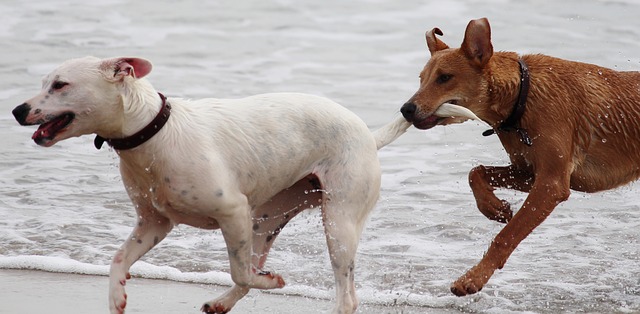We love every part of our dogs, including their tails. There are so many different varieties (curly, nubby, fluffy), they wag when our pups see us, and they’re an important part of the pooches we love most!
Every pup parent knows that their dog uses this appendage to express their emotions, but did you also know that it can clue you into your dog’s health, or that it’s tied to their emotional well-being?
These wagging wonders are more than just a decoration (but you knew that!). Don’t ever underestimate how complex and miraculous your dog really is… from his head to his tail! Below, check out 4 things you should know about your dog’s tail.

1. Tails are a tool for communicating
When we think of a dog wagging its tail, we always think about our own happy dogs that are pleased to see us or excited about a treat or activity. Dogs use their tails to communicate with each other and us, but it’s important to know that not all tail wags are friendly.
Depending on the speed of the wag and the elevation of the tail, a dog might be trying to demonstrate that he perceives you as a threat or intends to act aggressively. A high slow wag can be misinterpreted as a friendly wag, so if it is a dog you don’t know, do not assume that because he is wagging his tail he is happy to see you. It is always smart to proceed with caution when approaching an unfamiliar dog. See our post on 10 Things Your Dog’s Body Tells You What They Are Thinking to decode more dog body language!
2. They vary in lengths
Many dogs have long tails, some have short ones, and others are born with no tail at all, a trait that’s considered normal for certain breeds. Examples include English Bulldogs, Boston Terriers, Brittany Spaniels, and French Bulldogs, to name a few.
Although we think that nubby tails are cute, there can be issues associated with the genetic differences to the tail. A disorder loosely referred to as “screw tail” is when the vertebrae of the tail are malformed enough to twist the tail so close to the body that chronic recurrent infections and irritations occur between the tail and body. These patients may require surgical intervention to remove the tail completely.

3. They can clue you in to health issues
Sometimes the tail can be literally flagging you down to notice an issue with your dog’s health. Certain disorders can show themselves through the tail. Flea allergy dermatitis can cause skin irritation on and around the tail and rump. Skin infections from other causes can also affect the tail. Some hormonal disturbances such as hypothyroidism (decreased levels of thyroid hormone in the dog’s blood) can manifest as hair loss at the tip of the tail.
If your dog’s tail hair is thinning or falling out and leaving bald patches, be sure to ask your vet. There are treatment plans to manage many of the problems that could cause such signs.

4. They’re an integral part of your dog’s wellbeing
Dogs that were born with no tail never know what it’s like to have one, but we know that the tail can serve a purpose in physical balance and psychological well-being 1. There is even a suggestion that having a tail surgically docked can increase the chance of urinary incontinence 2. Probably the best advice about tails is this: if your dog has one, he should keep it unless its removal is medically necessary. Your veterinarian can help you determine what should be done about medical issues involving your dog’s tail, so be sure that you mention any concerns to him or her.
Do you love to learn about dogs? Find me on Facebook where we posted fun animal stuff everyday! Click here.
—–
- Leaver, SDA, Reimchen TE. Behavioural responses of Canis Familiaris to different tail lengths of a remotely-controlled life-size dog replica. Behaviour 2008;145:377-390.
- Thrusfield P, Holt M. Association in bitches between breed, size, neutering and docking, and acquired urinary incontinence due to incompetence of the urethral sphincter mechanism. Vet Rec 1993;133:177-180.

